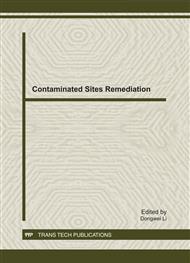p.1
p.5
p.16
p.22
p.27
p.32
p.39
p.45
Review of Contaminated Sites Remediation Technology
Abstract:
The contaminated site remediation is an important content of site management. Plans for the introduction of measures and requirements to prevent and remediate soil contamination, particularly through the development of inventories of contaminated sites and the definition of targets for prioritization of remediation actions, are expected to have important consequences for site management practice and national site policies. Nowadays contaminated soil and groundwater treatment technologies can be sorted as three categories, that is bioremediation, chemical treatment and physical treatment. Biodegradation generally refers to the breakdown of organic compounds by living organism eventually resulting in the formation of carbon dioxide and water or methane. Chemical remediation is a kind of method that chemical reagent, chemical reaction and chemistry principles are used to reduce the mobility, organisms use ratio of heavy metals and decrease the heavy metals in the soil so as to remediate and repair the soil. Physical treatments in the remediation of contaminated site contains revising methods, capping methods, stabilization methods, electrokinetic methods and so on.
Info:
Periodical:
Pages:
1-4
Citation:
Online since:
December 2011
Authors:
Price:
Сopyright:
© 2012 Trans Tech Publications Ltd. All Rights Reserved
Share:
Citation:


